Case report: Maryland bridges, or “is this really the best way to get to Delaware?”
Posted: August 25, 2017
Last Modified: March 19, 2021
The allure was strong: place a dental bridge without having to shave down a substantial amount of tooth structure like a conventional bridge. Bond that thing in and you have a tooth where there was none before! This type of bridge was developed at the University of Maryland in the early 1980’s (although provenance is disputed) and was quickly adopted into mainstream dentistry. A false tooth with a thin wing of metal bonded to the adjacent teeth. What could go wrong? This post describes a real-life-Maryland-bridge-gone-wrong and how we were able to correct it.
What is a Maryland Bridge?
When you see enough of these things you quickly see the problems that arise over and over again: darkening of the front teeth from the metal wings, and even more frustrating, debonding of one of the wings without any loosening of the other. You can’t take it off easily and you can’t rebond the loose part.
Here’s an example of just such a case from our office. A patient who was missing both her lateral incisors (the teeth next to the front teeth) had a long-span Maryland bridge placed at an early age (not by us, so don’t ask us why two smaller bridges weren’t done instead). Immediately after insertion of the bridge, the aesthetic drawbacks were obvious- the front teeth looked dark due to the metal wings. She hated it, but her parents had paid for it and it was already cemented into her mouth. Here’s another look, and that’s how it was for the next twelve years.
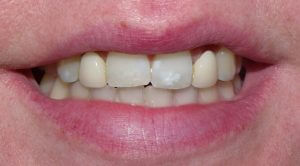
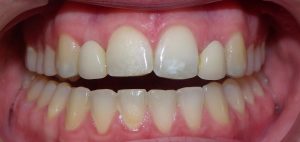
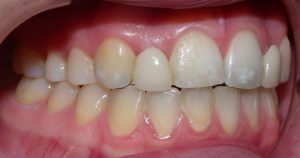
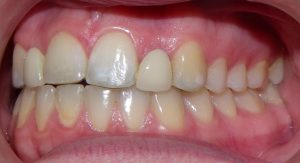
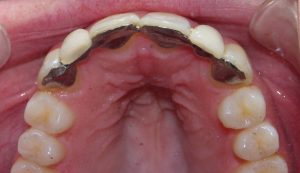
Not long ago, this patient returned to report that one of the wings had actually detached from the tooth. Not good, because it was still attached to 3 other teeth and that would have made removing and recementing very difficult. Incidentally, it is thought to be the movement of the supporting teeth in different directions when chewing that causes loss of bond strength.
The Solution
So what to do? We sectioned the bridge in the midline to see if we could just remove the bridge on that side and recement it, but still no luck. We were now forced to look at the replacement of the entire Maryland bridge.
This, as it turns out, was the patient’s opportunity: she could now i) whiten her teeth, and ii) replace that unsightly bridge with a solution that is more aesthetic and allows her to floss!
Although dental implants in the two spots would have been ideal, the root angulations of the adjacent teeth as well as the insufficient volume of bone made that impossible. After some discussion, we decided that the replacement of the bridge with two separate cantilever all-ceramic bridges was the best option.
Our patient wore a cheap-o acrylic partial denture to temporarily replace the missing teeth while she whitened and while the prostheses were being made by the lab. Surprise surprise, she hated it, but luckily it was only needed for a short time.
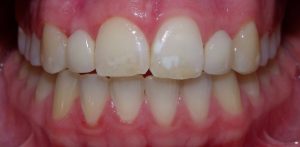
Here’s a picture of the big day! We finally got rid of the denture and bonded the two glass ceramic bridges onto her canine teeth (the third ones from the middle). We hope you’ll agree that the appearance is much better than the previous Maryland bridge, and she could actually floss her teeth as well without using a floss threader!
For the dental nerds: bilateral IPS e.Max bridges replacing lateral incisors, cantilevered off the canines. Teeth were air abraded with Danville PrepStart, acid-etched with Bisco’s phosphoric acid with Benzalkonium Chloride, and the prostheses were cemented with Calibra esthetic resin cement as per manufacturer’s instructions.
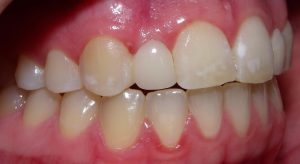
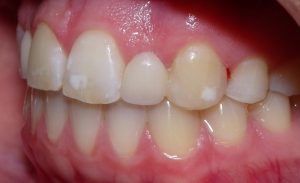
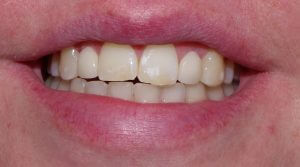
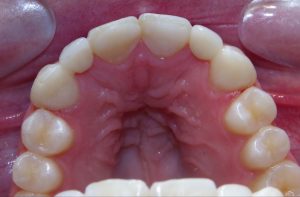
A final note: this is not a solution that can be used anywhere. Cantilever Maryland bridges have pretty poor survival in all other areas of the mouth except for upper lateral incisors, and it just so happened that not only did this patient have missing lateral incisors, the bite against them was very light. Being able to minimize the forces against these bridges means that we have a better expectation of long-term success. By bonding the prosthetic teeth to just one adjacent tooth instead of both, we avoid the twisting forces that likely led to the original debonding.
Hopefully, this gives some insight into the real-life issues with Maryland bridges, and how we need to troubleshoot them. If you have some concerns with your mouth, or would just like an overall exam, please contact us! We’d love to be your Barrie dentist.


